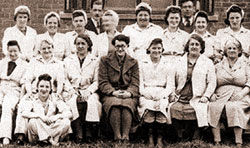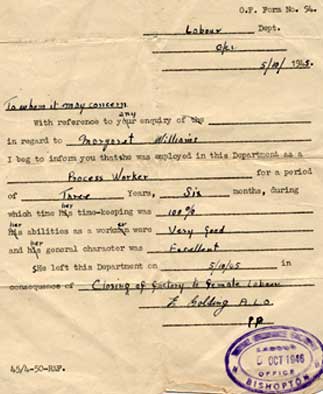 |
|||||||||||||||||||
|
|
|||||||||||||||||||
|
The photograph is of the ladies from the 'A' shift at the Royal Ordinance Factory at Bishopton, Glasgow in 1942. We made the components for floating mines and depth charges. That's me sitting cross-legged on the ground with my mother's hands on my shoulders. In order to arrive on time for the early shift I had to get up at four in the morning, walk a mile and a half, catch a train at ten minutes to five from Blantyre station and then walk a few yards to the factory gate. |
|||||||||||||||||||
 |
|||||||||||||||||||
|
We changed in a special area and all of us were dressed in white jackets and trousers, white turbans to keep your hair out of the way and rubber boots because the plant was never allowed to dry out to prevent explosions. It was forbidden to come out of the plant wearing your wellies! To maintain security and safety we were not allowed to carry hairpins, safety pins or any other metal items because even the smallest spark could put everyone's lives at risk. Male workers known as 'danger building men' carried out spot checks for any items likely to endanger the workers. I had only been there for two days when I forgot to remove a hairpin from my hair. I was suspended for a week. I didn't forget again! All workers were then searched for cigarettes, tobacco, lighters and matches. These items were considered to be 'contraband' and if they were found on your person you could be either sacked or suspended. I was twenty at the time and knew that if I were to be called up the choices could be forces or munitions. My father suggested that I didn't wait to be called up and to take the opportunity to find work in the munitions factory. The job helped with the war effort, but also earned good wages. If I worked in a reserved occupation it would be unlikely that I would be made to join the forces and probably sent away from home. The factory produced its wares for twenty-four hours a day, seven days a week. My section made 'squares' and 'plugs' from gun cotton. Raw gun cotton was delivered to the factory by rail - it resembled flakes of snow and it was stored in vats where it was mixed with water and other chemicals. The mixture was processed, tested and finally drained off. It was then piped to the individual machines where it arrived, looking a little bit like flour, to be blended by shovelling it from one bin to another and back again until it was ready for use. It was then weighed and pressed into shape. In the drilling room, holes were put into the blocks and the cores which were then dipped in acetone to give them a protective coating. They were then dispatched and became part of the detonator assembly for depth charges and other explosive devices. My section was only one of a number of different buildings scattered over the factory site. The most dangerous places to work were those which dealt with cordite and the highly explosive nitro-glycerine. These buildings were underground and the only evidence of their existence was a number of huge, grass covered mounds. The women who worked there had the same uniform as us, but wore felt soled shoes. I remember one day coming in to start the 2 - 10 pm shift. It was a lovely day and I was chatting to some men from the machine shop when, without warning, there was a huge bang. We all looked up to see the flames and smoke leaping skyward. One of the cordite houses had 'gone up'. There was loss of life, perhaps only two or three but it was sad. You just had to go on with what you were doing. You had service men relying on you. There was no official explanation given to us. Information was rarely shared as we were all conscious that 'careless talk costs lives'. Various stories went around that the explosion was caused by someone cleaning the machine with a brush. Possibly a hair from the brush got into the mechanism and caused a spark. I can only remember shutting down the machines once. I was on the 10 pm - 6am shift when German bombers attempted to destroy the shipyards on the Clyde. We all stood in silence and watched the bombs miss their target and devastate hundreds of tenement buildings instead. We later learned of a reconnaissance aircraft shot down on its way back from the raid loaded with film which, when developed, revealed clear pictures of the Bishopton factory. It was a good thing for us that it didn't get back to Germany.  At the end of the war, Margaret left employment at the factory as it closed it's gates to female workers. She was given a reference, however, which could be presented to future employers if she applied for work.
At the end of the war, Margaret left employment at the factory as it closed it's gates to female workers. She was given a reference, however, which could be presented to future employers if she applied for work.The reference read: To whom it may concern. With reference to any enquiry in regard of Margaret Williams, I beg to inform you that she was employed in this department as a Process Worker for a period of three years, six months, during which time her time-keeping was 100%. Her abilities as a worker were Very Good and her general character was excellent. She left this department on 3/10/45 in consequence of closing of factory to female labour. |
|||||||||||||||||||
| Top of page | Back | ||||||||||||||||||